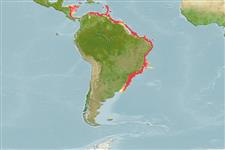>
Eupercaria/misc (Various families in series Eupercaria) >
Lutjanidae (Snappers) > Etelinae
Etymology: Pristipomoides: Greek, pristis = saw + Greek, poma, -atos = cover, operculum + Greek, oides = similar to (Ref. 45335).
Environment: milieu / climate zone / depth range / distribution range
Ökologie
seewasser demersal; tiefenbereich 50 - 220 m (Ref. 47377), usually 50 - 150 m (Ref. 9626). Tropical; 35°N - 36°S, 86°W - 33°W (Ref. 55)
Western Atlantic: southeastern USA to Uruguay (Ref. 9626).
Size / Gewicht / Alter
Maturity: Lm ? range ? - ? cm
Max length : 23.3 cm TL Männchen/unbestimmt; (Ref. 47377); common length : 21.0 cm TL Männchen/unbestimmt; (Ref. 9626)
Rückenflossenstacheln (insgesamt): 10; Rückenflossenweichstrahlen (insgesamt): 12; Afterflossenstacheln 3; Afterflossenweichstrahlen: 8. Interorbital space flat. Eye large. Pectoral fins not reaching level of anus. Scale rows on back parallel to lateral line. Back and upper sides yellow-orange or pinkish; lower sides and belly silvery white; the caudal fin and the distal edge of the dorsal fin yellowish or orange; the remainder of the dorsal and other fins translucent or whitish.
Although the habitat is poorly known, most specimens have been trawled from relatively deep water at the upper edge of the continental shelf. Reported to occur on soft or semi-hard bottoms (Ref. 5217).
Life cycle and mating behavior
Geschlechtsreife | Fortpflanzung | Ablaichen | Eier | Fecundity | Larven
Allen, G.R., 1985. FAO Species Catalogue. Vol. 6. Snappers of the world. An annotated and illustrated catalogue of lutjanid species known to date. FAO Fish. Synop. 125(6):208 p. Rome: FAO. (Ref. 55)
IUCN Rote Liste Status (Ref. 130435)
Bedrohung für Menschen
Harmless
Nutzung durch Menschen
Fischereien: weniger kommerziell
Mehr Information
NamenSynonymeMetabolismusRäuberÖkotoxikologieFortpflanzungGeschlechtsreifeAblaichenSpawning aggregationFecundityEierEientwicklung
ReferenzenAquakulturAquakultur ProfilZuchtlinienGenetikElectrophoresesVererbbarkeitKrankheitenVerarbeitungNutrientsMass conversion
PartnerBilderStamps, Coins Misc.LauteCiguateraGeschwindigkeitSchwimmstilKiemenoberflächeOtolithsGehirngrößeSehfähigkeit
Tools
Zusatzinformationen
Download XML
Internet Quellen
Estimates based on models
Preferred temperature (Ref.
123201): 17.2 - 26.3, mean 22.2 °C (based on 127 cells).
Phylogenetic diversity index (Ref.
82804): PD
50 = 0.5005 [Uniqueness, from 0.5 = low to 2.0 = high].
Bayesian length-weight: a=0.01514 (0.00719 - 0.03187), b=2.97 (2.80 - 3.14), in cm total length, based on LWR estimates for this species & Genus-body shape (Ref.
93245).
Trophic level (Ref.
69278): 3.7 ±0.5 se; based on size and trophs of closest relatives
Widerstandsfähigkeit (Ref.
120179): hoch, Verdopplung der Population dauert weniger als 15 Monate. (Preliminary K or Fecundity.).
Fishing Vulnerability (Ref.
59153): Low vulnerability (13 of 100).
